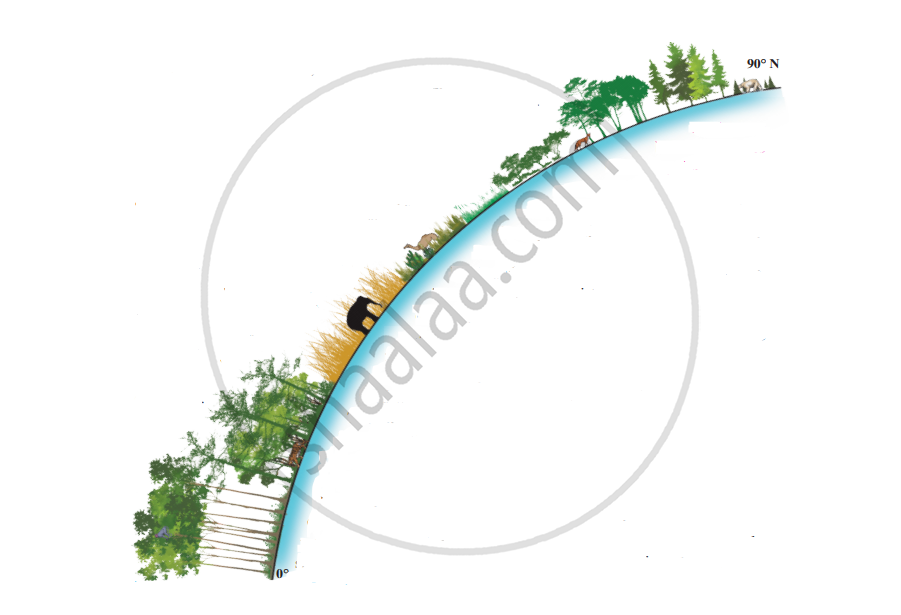Advertisements
Advertisements
Question
Look at the figure Answer the following questions:

- What does the figure show?
- What do the numbers on the figure represent?
- How does latitude influence the vegetation?
- How does latitude influence the fauna of a place?
- Which latitude will have more biodiversity?
Solution
- The figure shows the vegetation and animal life from the equator to polar areas.
- The numbers in the figure represent latitudes.
- Vegetation in any area depends upon the elements of climate such as temperature, rainfall, humidity, soil condition and amount of insolation received. These conditions vary with latitude. For example, in the lower latitudes that is near the equator there is a hot and wet climate, so dense evergreen forests grow. But in higher latitudes due to extreme cold climate and heavy snowfall, there are hardly trees but mosses and lichen grow.
Following vegetation grows in different latitudes.
0° to 10°N and S - Dense, evergreen, hardwood forest
5° to 30°N and S - Tropical deciduous forest
10° to 20°N and S - Tropical grasslands
20° to 30°N and S - Tropical Desert.
30° to 40°N and S - Mediterranean (Evergreen and Deciduous Forest)
40° to 50°N and S - Temperate Deciduous Forest.
40° to 55°N and S - Temperate Grasslands
50° to 55°N - Taiga (Coniferous Forests)
65° to 90° N - Tundra - As the vegetation changes with latitude, depending upon vegetation and climate, fauna also changes as per the following.
0° to 10°N and S - Monkeys, birds from the vulture family, hornbills, parrots, various species of insects, butterflies, and reptiles.
5° to 30°N and S - Microscopic organisms to large elephants, hippopotamus, rhinos, tiger, lion, gaur, monkeys, etc.
Birds: Coucal, hornbills, Asian koel, peacock, vultures, falcon, pigeons, sparrows, etc.
Insects: Ants, butterflies, insects, and worms are in plenty.
10° to 20° N and S - Rich in herbivore animals, ranging from rabbits to elephants. Main species - antelopes, buffalo, zebra, rhinos, wild beasts, giraffes, warthogs, etc. The carnivore like cats, lions, leopards, cheetah, wild dogs, jackals, hyenas, etc.
Birds: Vulture, great Indian bustards, Twitter, and ostriches.
20° to 30° N and S - Mainly carnivores, camels, rats, mongoose, desert turtles, many species of snakes, types of lizards, goats, sheep, donkeys, etc.
Insects: Houseflies, beetles, moths, types of termites, etc.
30° to 40° N and S- Rabbits, deer, goats, pigs, horses, brown bears, fix, berry deer, wild cats, goats, and sheep.
Birds: Vultures, eagles,
Alligators, reptiles.
Insects: Various types of insects and honeybees.
40° to 50° N and S - Animals having thick and soft fur-like brown bears, red fox, sable, mink, etc. are found.
Birds: Peregrine, falcon, woodpecker, cardinals.
Insects: Many types of insects.
40° to 55° N and S - Rich and varied animal life. Herbivores include gazelles, zebras, wild horses wolves, deer, rabbits, the coyote is a carnivore. Ostriches are found in veld grasslands. Kangaroos and dingoes are found in the Downs of Australia.
50° to 55°N -The animals have thick hides and a thick layer of fats and are hairy. E.g., reindeer, grizzly bears, elk, caribou, etc., are herbivores. Fox mountain lions, puma, and panthers are the carnivores.
65°N to 90°N - Very scarce animal life. Thick fur and layer of fats in their body helps them to face very cold climate. Herbivores such as musk ox, bears, reindeer, caribou, lemming, rabbits along with carnivores like Arctic fox, dogs, jackals are found.
Birds: Ptarmigan, ravens, snowy owls, and redpolls are found. The majority are migrants. Seals, walruses are found in coastal areas. - Biodiversity is very high at 0° to 10° N and S and 5° to 30° N and S.
APPEARS IN
RELATED QUESTIONS
Besides latitudes, what other conditions influence the biome?
In which region in India, is desertification occurring?
Read the following news item.
A grizzly bear that killed a mother and her baby in Yukon last fall was emaciated and desperately pursuing unusual food sources at the time of the attack, according to an investigation by the territory’s government. Valérie Théorêt, 37, and her 10-month-old daughter, Adèle Roesholt, died on Nov. 26, 2018, when a grizzly bear attacked them near their trapping cabin in the remote Einarson Lake area northeast of the village of Mayo. Gordon Hitchcock, chief conservation officer for the Government of Yukon, said the 18-year-old male grizzly bear was emaciated to the point that it was incapable of hibernation. Additionally, it was insignificant and chronic pain from having eaten a porcupine – which bears do not typically eat – and had quills penetrating its digestive system from the mouth to stomach. “This bear had started turning to uncommon food sources,” said Mr. Hitchcock, who presented findings of a necropsy in Whitehorse on Wednesday. - CNN News
- Why do such things occur?
- Give examples of such similar incidents in Maharashtra wherein some animal has attacked people in a particular region.
Complete the chain:
| A | B | C |
| 1) Boreal forest | 1) Hard wood species of trees | 1) Siberia |
| 2) Deserts | 2) Tropical deciduous forest | 2) Myanmar |
| 3) Teak | 3) Wide spectrum of bio-diversity | 3) Sahara Desert |
| 4) Tropical rain forest | 4) Tundra Region | 4) Brazil |
| 5) Taiga forest | 5) Greenland | |
| 6) Narrow spectrum of bio-diversity |
Fill in the blank with appropriate alternatives given below and rewrite the sentence.
Ecosystem consists of interaction between ____________ and abiotic factors.
Fill in the blank with appropriate alternatives given below and rewrite the sentence.
The original meaning of savanna is____________
Arrange the given statements as per given instructions.
Arrange the following biomes in proper order from the Equator to Pole.
- Tundra
- Tropical rain forest
- Boreal forest
- Sahara desert
